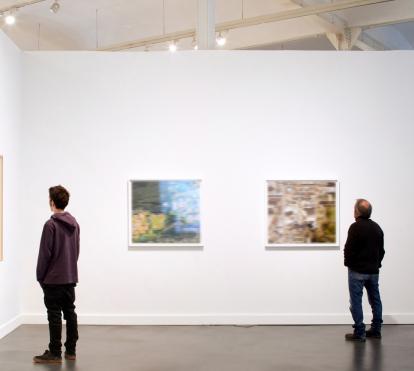
Surgical steel, the rubber of a baby's pacifier, bar codes, multicoloured papers, plastic, stitches of crochet, coal... Many 21st century artists have found an open field for experimentation in jewellery. This goes beyond mere materials to include shapes, colours and uses. One hundred metres of profusely knotted thread is all Mah Rana (London, 1964) needed to eternalise her memory of the first time she tied her shoelaces. Felieke van der Leest (Emmen, Holland, 1968) uses crochetwork to turn her "soft" jewellery into amulets to decorate one's body in loud colours. It is no coincidence that contemporary creators have "deconstructed" jewellery in an attempt to (sometimes humorously) question the established codes of the body, the economy and society. With the title Interior luxury. International contemporary jewellery, CaixaForum exhibits the evolution of the latest trends through 75 innovative and conceptual pieces elaborated by 32 artists from 17 different countries, all of them born after 1960. The exhibition, organised and produced by ”la Caixa” Foundation with the collaboration of the FAD Goldsmiths organisation, is presented within the framework of the Year of Design 2003. Interior luxury. International contemporary jewellery, organised by Mònica Gaspar Mallol, can be viewed at CaixaForum (Av. del Marquès de Comillas, 6-8), from 18 June to 28 September, 2003. Beauty, perfection, magic, power: these are just some of the attributes that have been intrinsically linked to jewellery since ancient times. Without foregoing this symbolism, contemporary artists have expanded upon jewellery's uses, meanings, shapes and materials. This is conveyed in Interior luxury. International contemporary jewellery, which unites a selection of 75 pieces which not only show the exceptional quality of these seductive creations, but also challenge visitors' imaginations. According to the organiser, "The interior is not visible at first glance. It's hidden. It takes effort to get there. To the contrary, luxury is based on an excess of visibility." This showing evokes the spirit of Contemporary European jewellery, an exhibition organised twenty years ago by the Caixa de Pensions Foundation, which meant many people's introduction into contemporary jewellery. Interior luxury is now presented within the context of Year of Design 2003, coinciding with the centennial celebration of FAD (1903-2003), a forerunning entity in the promotion of design, architecture and applied arts in Catalonia. The exhibition is divided into six thematic ambits which analyse the relationship between jewellery and the body, memory, communication and language; the dialectic of humble and precious materials, or that existing between natural and artificial shapes, and a work process that has recovered traditional goldsmithing techniques, while at the same time opening itself to the immensely varied manifestations that can be taken by the art of objects. The exhibition is focused on the generation of jewellers born between 1960 and the early 70's in Europe, though it also includes creators from other parts of the world, such as Australia and Japan, by virtue of their link to certain European schools which have ultimately shaped their careers. With a healthy sense of humour, David Bielander (Basilea, Switzerland, 1968) uses materials commonly related with the body, such as the rubber of pacifiers or the latex of condoms, in his jewellery. Fascinated by the frigid beauty of the steel prostheses implanted in human bodies, Christoph Zellweger (Lübeck, Germany, 1962) presents a series of jewels imbued with a clinical and critical spirit. The works of Xavier Ines Monclús (Barcelona, 1966) transmit lyrical or scathing messages on everyday life under the harmless guise of a toy. The aesthetics of medals and badges have inspired Dutch creator Machteld Van Joolingen (Rotterdam, 1962) to reflect on ornaments' capacity to classify people, or discriminate against them. On another front, the prolific family of plastics (the new noble material of modernity), the variety of finishings and textures and a limitless array of colours are represented in the exhibition via various creations.Artists present in Interior luxuryTeru Akatsu (Tokyo, Japan, 1970), Peter Bauhuis (Friedrichshafen, Germany, 1965), David Bielander (Basilea, Switzerland, 1968), Lin Cheung (Hampshire, United Kingdom, 1971), Hilde de Decker (Dendermonde, Belgium, 1965), Xavier Domènech (Barcelona, 1960), Iris Eichenberg (Göttingen, Germany, 1965), Ute Eitzenhöfer (Bruchsal, Germany, 1969), Cristina Filipe (Lisbon, Portugal, 1965), Karl Fritsch (Sonthofen, Germany, 1963), Estela Guitart Xicola (Barcelona, 1970), Andi Gut (Zug, Switzerland, 1971), Sophie Hanagarth (Laussane, Switzerland, 1968), Piret Hirv (Talin, Estonia, 1969), Xavier Ines Monclús (Barcelona, 1966), Mari Ishikawa (Kyoto, Japan, 1964), Svenja John (Duisburg, Germany, 1963), Jutta Klingebiel (Freising, Germany, 1969), Auli Laitinen (Stockholm, Sweden, 1967), Stefano Marchetti (Padua, Italy, 1972), Sally Marsland (Mount Beauty, Australia, 1969), Paul McClure (Toronto, Canada, 1967), Itxaso Mezzacasa (San Sebastián, 1975), Marc Monzó (Barcelona, 1973), Adam Paxon (Penrith, United Kingdom, 1972), Mah Rana (London, United Kingdom, 1964), Andronikos Sagiannos (Athens, Greece, 1968), Janna Syvänoja (Helsinki, Finland, 1960), Felieke van der Leest (Emmen, Holland, 1968), Machteld Van Joolingen (Rotterdam, Holland, 1962), Silvia Walz (Gelsenkirchen, Germany, 1965) and Christoph Zellweger (Lübeck, Germany, 1962). Interior luxury. International contemporary jewelleryFrom 18 June to 28 September, 2003CaixaForumAv. Marquès de Comillas, 6-808038 Barcelonawww.fundacio.lacaixa.esTel.: 902 22 30 40Hours:Tuesday to Sunday and holidays, 10 am to 8 pmWednesdays in July and August, 10 am to 12 amMondays closed, except for holidaysFree admissionwww.fundacio.lacaixa.es